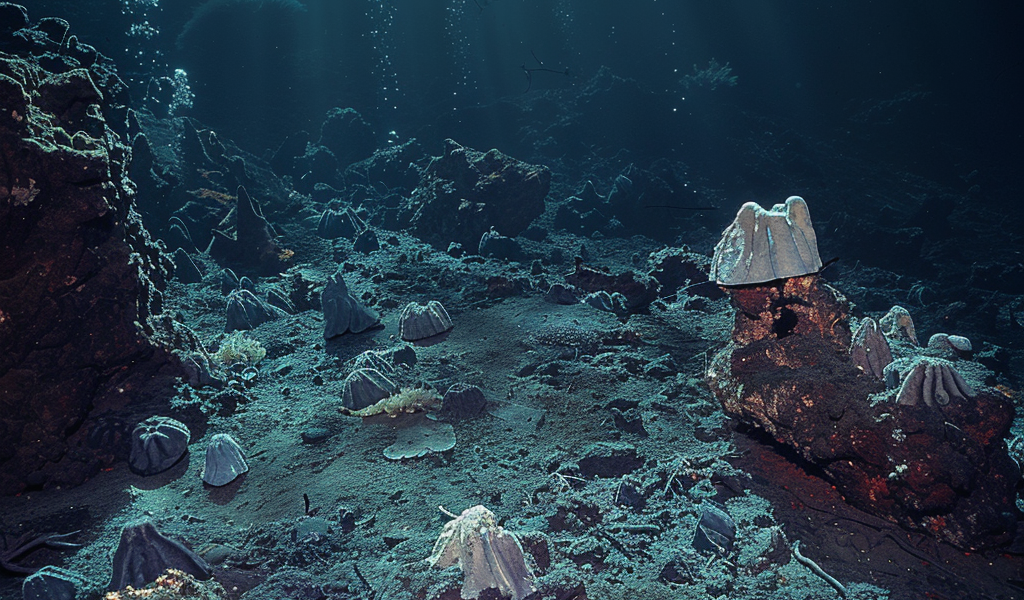In a groundbreaking discovery, researchers have unveiled a remarkable phenomenon occurring in the depths of the Pacific Ocean, where oxygen is being generated not by living organisms, but by unusual metallic formations known as polymetallic nodules. These potato-shaped lumps, found four kilometers beneath the ocean’s surface in an area called the Clarion-Clipperton Zone (CCZ), exhibit properties similar to that of AA batteries, producing what scientists have termed “dark oxygen.” This revelation challenges long-held beliefs about the origins of life on Earth and the processes involved in oxygen production.
Traditionally, it has been understood that photosynthesis, which requires sunlight, is the primary means through which living organisms like plants and algae produce oxygen. However, the recent study conducted by an international team of scientists has shown that these mineral deposits can generate oxygen in total darkness, leading to significant implications for our understanding of life’s beginnings and the ecological dynamics of deep-sea environments.
The polymetallic nodules, often referred to as “batteries in a rock,” are rich in essential metals such as cobalt, nickel, copper, and manganese. These metals are critical for various applications, including batteries, smartphones, wind turbines, and solar panels. As mining companies prepare to harvest these valuable resources from the ocean floor, understanding the ecological impact of such activities has become increasingly important.
To investigate the effects of potential mining on the unique and poorly understood organisms residing in the abyssal plain, the research team deployed a small vessel to the CCZ. The study aimed to measure the rate of oxygen consumption by the seafloor, a task that was accomplished using a specialized device known as a benthic chamber. This chamber collects sediment from the ocean floor and is designed to monitor changes in oxygen levels.
Typically, when organisms respire within the chamber, the oxygen levels decrease as it is consumed. However, in this instance, the researchers observed an unexpected increase in oxygen levels. This finding was particularly astonishing given the complete absence of light in the depths of the ocean, where photosynthesis is impossible.
Lead study author Andrew Sweetman from the Scottish Association for Marine Science expressed his astonishment at the results, noting that the increase in oxygen was not anticipated. The implications of this discovery are profound, suggesting that there may be alternative biochemical processes at play in the deep ocean that have yet to be fully understood.
The Clarion-Clipperton Zone, a vast area stretching from Hawaii to Mexico, has garnered interest from mining companies due to its rich deposits of polymetallic nodules. As exploration and extraction activities ramp up, scientists are emphasizing the need for careful consideration of the environmental impacts associated with such operations. The unique ecosystems that thrive in the dark, cold depths of the ocean may be more delicate than previously thought, and the introduction of mining activities could have unforeseen consequences.
This discovery of dark oxygen production raises important questions about the adaptability of life in extreme environments and the potential for life to exist in forms that are not yet understood. As researchers continue to explore the depths of the ocean, they may uncover more surprises that challenge existing paradigms about life on Earth and the conditions necessary for its emergence.
The findings from this study have sparked interest and debate among scientists, prompting further investigations into the biochemical processes occurring in the deep sea. Understanding how these metallic nodules contribute to oxygen production could provide valuable insights into the ecological dynamics of the ocean floor and the potential impacts of human activities on these fragile ecosystems.
As the world grapples with the challenges of resource extraction and environmental conservation, the lessons learned from the Clarion-Clipperton Zone may serve as a critical reminder of the interconnectedness of life and the need to tread carefully in our exploration of the planet’s last frontiers.





